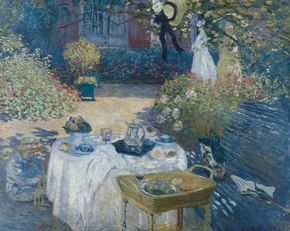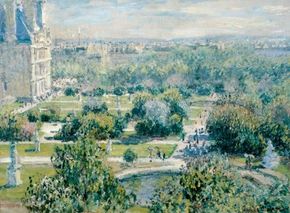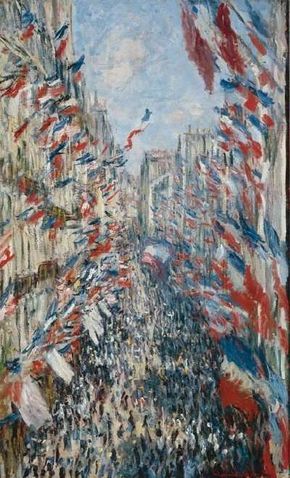Claude Monet was only one of the loose-association artists who called themselves the Societe Anonyme, but his innovative work dominated all discussions about the unorthodox exhibition. His seascape gave the group its name, and his approach -- daring to capture the transitory effect of an instant rather than portraying the topographical features of a stable view -- redefined the objectives of landscape painting.
In the years that followed, Monet participated in five of the eight Impressionist exhibitions, and, more than any other member of the circle, he established Impressionism as a revolutionary -- and ultimately triumphant -- force in contemporary art. Over the years, the works Monet selected to present at the Impressionist exhibitions proved to be flash points in the reception of the group's experimental endeavors.
Advertisement
His own point of view remained unassailably modern. To capture the energetic spirit of Paris, Monet had positioned his easel at a high window overlooking the street. Writing about Boulevard des Capucines (1873-74), the critic Jules Castagnary proposed, half in jest, that to see the painting properly, he would have had to view the painting through the windows of the house across the street.
Along with the urban street scene, Monet asserted his modernism by accepting without judgment the visual contradictions of contemporary life, such as the incursion of a massive new road bridge in his tranquil view over the Seine in Bridge at Argenteuil (1874; shown in the second Impressionist exhibition, 1876).
Monet continued to paint figures in the open air, as seen in Woman with a Parasol -- Madame Monet and Her Son (1875; shown in the second Impressionist exhibition, 1876). The portrait of Camille and Jean on a hill against a pale blue sky captures a breeze buoying Camille's parasol and blowing the thin fabric of her veil across her face. With their indistinct features, the figures appear anonymous; the sudden summer wind rather than the sitters is the focus of attention.
Monet ended his association with the Impressionists when he declined to enter his work in the last exhibition in 1886. But his reputation endured as the leader of a daring development in the arts, and most critics came to agree that Monet stood out among the Impressionist painters.
- Boulevard des Capucines: Monet captures the hubub of Paris life on a wintry day in this bird's-eye view.
- The Luncheon, Monet's Garden at Argenteuil: This painting shows the intimacy and informality of Monet's daily life.
- Autumn in Argenteuil: Autumn in Argenteuil is one of the watery scenes that shows Monet's signature style.
- The Poppy Field, near Argenteuil: Camille and Jean Monet grace the foreground of this landscape painting.
- The Train in the Snow: Monet's Train in the Snow shows his ongoing interest in the convergence of nature and technology.
- Unloading Coal: This gritty urban scene proves that Monet was as interested in portraying city life as he was in showing peaceful nature scenes.
- An Apartment Corner: An Apartment Corner is one of Monet's rare interior scenes.
- Woman with a Parasol -- Madame Monet and Her Son: Camille and Jean Monet are featured in many of Monet's paintings, including Woman with a Parasol -- Madame Monet and Her Son.
- The Tuileries: This aerial view of a formal garden shows Monet's mastery in portraying light.
- Corner of the Garden at Montgeron: Monet was commissioned to paint Corner of the Garden at Montgeron, but never collected the fee.
- Turkeys: Some critics said the subject matter of this piece was ridiculous, but this fowl painting shows a rare example of animal life in a Monet work.
- The Hunt: In this striking work, a group of hunters searches amid an orange and scarlet landscape.
- La Gare Saint-Lazare. Les signaux: Monet captures a snapshot of urban life in his portrayal of the Saint-Lazare train station.
- La Gare Saint-Lazare: Another painting of the train station, La Gare Saint-Lazare is alive with light, steam, and motion.
- Rue Montorgueil in Paris, Festival of 30 June 1878: Monet painted this bold work to celebrate the opening of the International exhibition.
Learn about Boulevard des Capucines, a bustling street scene, in the next section.
To learn more about art, famous artists, and art history, check out:
Advertisement














